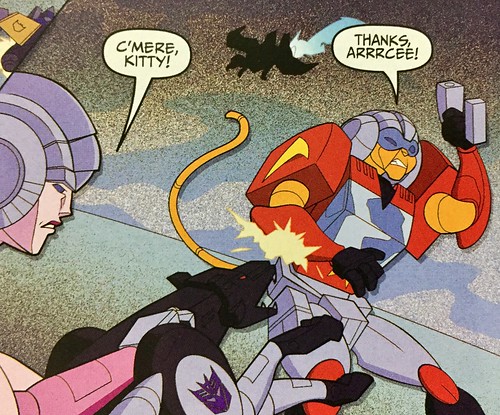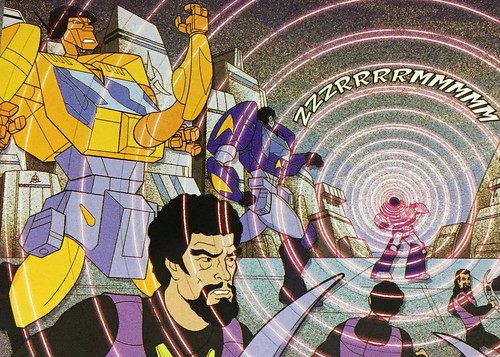“The Practical Joker" (Sept. 21, 1974)
The same writers, Chuck Menville and Len Janson, who penned “Once Upon A Planet” now give us this story. The original outline was rather sparse yet still outlined the Enterprise being infected by alien entities that have an off-beat sense of humour just after escaped three pursuing Romulan warships.
Something about this interested Roddenberry although he nixed the idea of alien entities and suggested the ship’s computer being affected by some exotic energy field. He also suggested the tricks being played by the computer be more practical in nature rather than exotic. Otherwise the story remained relatively intact.
At this point, without Dorothy Fontana’s presence, Roddenberry was communicating with Lou Scheimer or directly with the writers and usually by phone.
This is basically a love it or hate it episode. It was originally meant to be sillier, but Roddenberry wanted to add a measure of jeopardy to it. Seeing it now, after so many TNG/DS9/VOY episodes where the ship’s computer and/or holodeck goes haywire, strikes me as being even more disappointing than I remembered it. It’s not really a novel idea given the Enterprise’s computer did get weird in “Tomorrow Is Yesterday” and was temporarily taken over by Redjac in “Wolf In The Fold.” Later another malevolent entity took control again in “Beyond The Farthest Star.” The Shoreleave Planet computer also takes control of the Enterprise computer in “Once Upon A Planet.” So, by now it feels truly done to death and not nearly as interesting.
The only thing I found of interest in this story was the introduction of the holographic recreation room, an idea Roddenberry had conceived of way back during TOS’ first or second season and finally realized onscreen here. Of course, that idea would be polished off and reintroduced prominently thirteen years later in TNG.
And, yes, I have no love for this episode.
“Albatross” (Sept. 28, 1974)
The original concept of this story is that a bounty hunter chases down the Enterprise (after it delivers medical supplies) and boards the ship to arrest McCoy who is charged with causing the deaths of countless people after a medical experiment gone wrong decades previously. Dorothy Fontana handled the original treatment and revisions with the writer in 1973 during TAS’ first season. Eventually the story was massaged into a form more closely resembling the final episode, but at some point Roddenberry appears to have soured on the story and cut it off and dismissed it in favour of “The Slaver Weapon.”
At some point after Fontana left TAS the story was resurrected and a new writer polished it off into the final aired form. Demos the bounty hunter was now a Dramian Security Officer. McCoy is arrested after the Enterprise drops off its supplies but just before it departs. The medical experiment (supposedly on a prison planet) became providing medical aid on a Dramian colony. And a sympathetic plague survivor is introduced to help clear McCoy of the erroneous charges of mass murder.
The final product is not a ripping adventure, but it isn’t bad either. It’s quite serviceable in a lowkey way. We get to see some exotic aliens and a desolate alien landscape. Kirk and Spock go the distance to help McCoy. What else can you ask for?
For me this was a pleasant rebound after the silliness of “The Practical Joker.”
“How Sharper Than A Serpent’s Tooth” (Oct. 5, 1974)
One thing about early Star Trek—the episode titles often seemed to evoke lines of classic literature.
This is really little more than a retelling of TOS’ “Who Mourns For Adonais?” with Kulkulkan standing in for Apollo. The crew have to figure out a puzzle before the winged serpent god makes his appearance, but then it’s pretty similar to the previous live-action story in the crew showing that humans are no longer simple and superstitious beings ready to worship anyone who can put on a good light show.
Kukulkan has a pretty wicked looking ship which he disguises with a projection of a fearsome winged serpent, but the Enterprise crew aren’t fazed in the least by this parlour trick.
Russell Bates was a Native American who pitched a story to TOS back during the show’s second season. At the time he communicated with Dorothy Fontana and Gene Coon. After Fontana and Coon left TOS Bates’ story appears to have fallen through the cracks and nothing more was seen or heard of it. Flash forward some years later and Fontana contacts Bates asking him to pitch to TAS. Eventually Bates collaborated with a David Wise on a story called “The Thunderbird” which dealt with the Enterprise encountering a being that might well have inspired legends among various ancient Native American peoples. The Thunderbird was eventually changed to Kukulkan of Mayan legend and led to the episode finally produced. Throughout the story’s evolution remained a character named Dawson Walking Bear given Dorothy Fontana wanted an Indian crewmember aboard the Enterprise.
Animation allowed us to see things that would have been impossible in live-action such as in “Who Mourns For Adonais?” In that sense it’s a more visually interesting effort than what we got previously. But in terms of being engaging and having dramatic impact it pales in comparison to the live-action episode.
“The Counter-Clock Incident” (Oct. 12, 1874)
Fred Bronson first met Gene Roddenberry during TOS’ first season. Several years later he would encounter Roddenberry again while working at NBC while Roddenberry was developing The Questor Tapes. He also served at NBC as publicist for TAS. Prior to TAS’ second season Bronson, a fan of Star Trek, claims to have confided in Lou Scheimer to allow him to submit a story under the name John Culver.
Bronson was inspired by a story written by Philip K. Dick dealing with time running backward. From that he conceived of a story where the Enterprise is thrown into an alternate universe where time flows in reverse. He also chose to introduce the character of now retired Robert April who was the Enterprise’s first Captain, inspired by Roddenberry’s initial concept for Star Trek as Bronson read it in Stephen E. Whitfield’s The Making Of Star Trek.
This really is a mind-bending idea. And one’s enjoyment of it all hinges on whether you can wrap your heard around it. It doesn’t pay to have a critical perspective as you begin questioning how so many things we accept in our familiar reality could possibly happen in a universe where everything happens in reverse.
Speaking for myself this simply just doesn’t work and TAS’ swan song ends the series with a disappointing WTF!
TAS started by hitting the ground running, but at the end it limped off into televiion history.




 Not in the episode I remember. I don't have it on DVD, and haven't seen it in over thirty years, so I'll take your word for it. As Orko and Bat-Mite were both voiced by Lou Scheimer, I could be putting Bat-Mite's words in Orko's mouth. But the rest, the visit to Orko's home and his magic working perfectly, is accurate.
Not in the episode I remember. I don't have it on DVD, and haven't seen it in over thirty years, so I'll take your word for it. As Orko and Bat-Mite were both voiced by Lou Scheimer, I could be putting Bat-Mite's words in Orko's mouth. But the rest, the visit to Orko's home and his magic working perfectly, is accurate.
